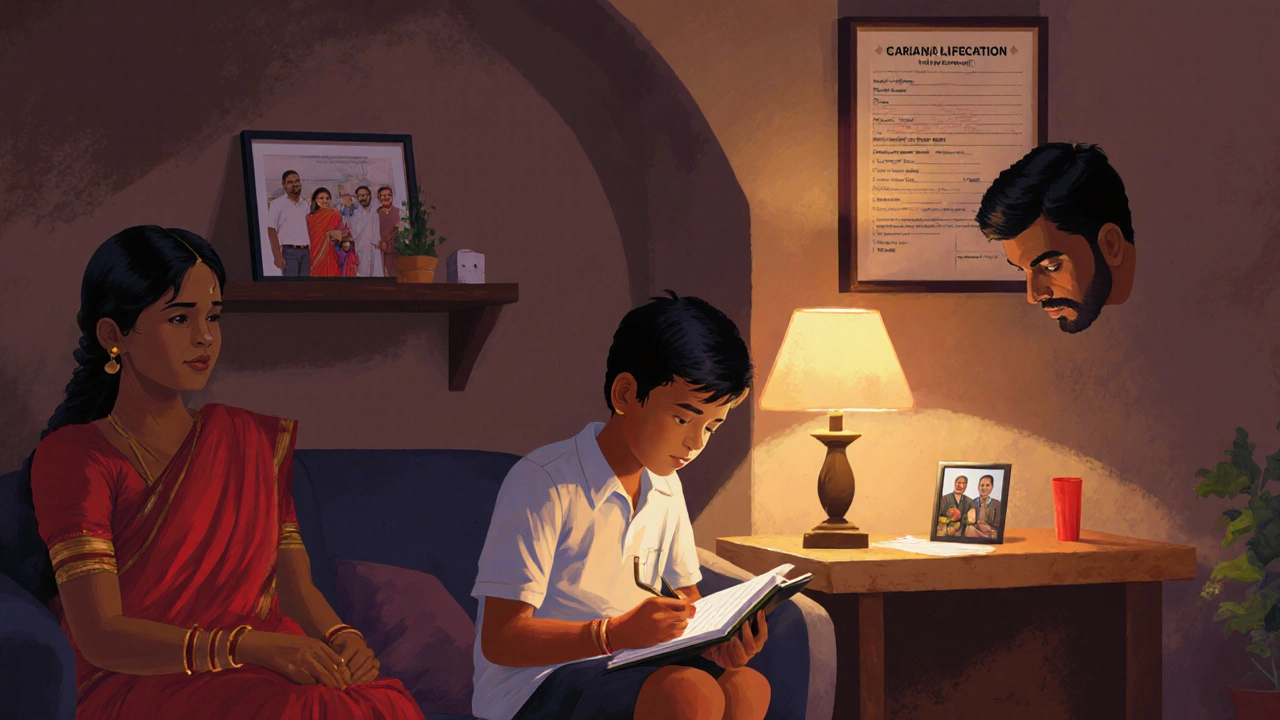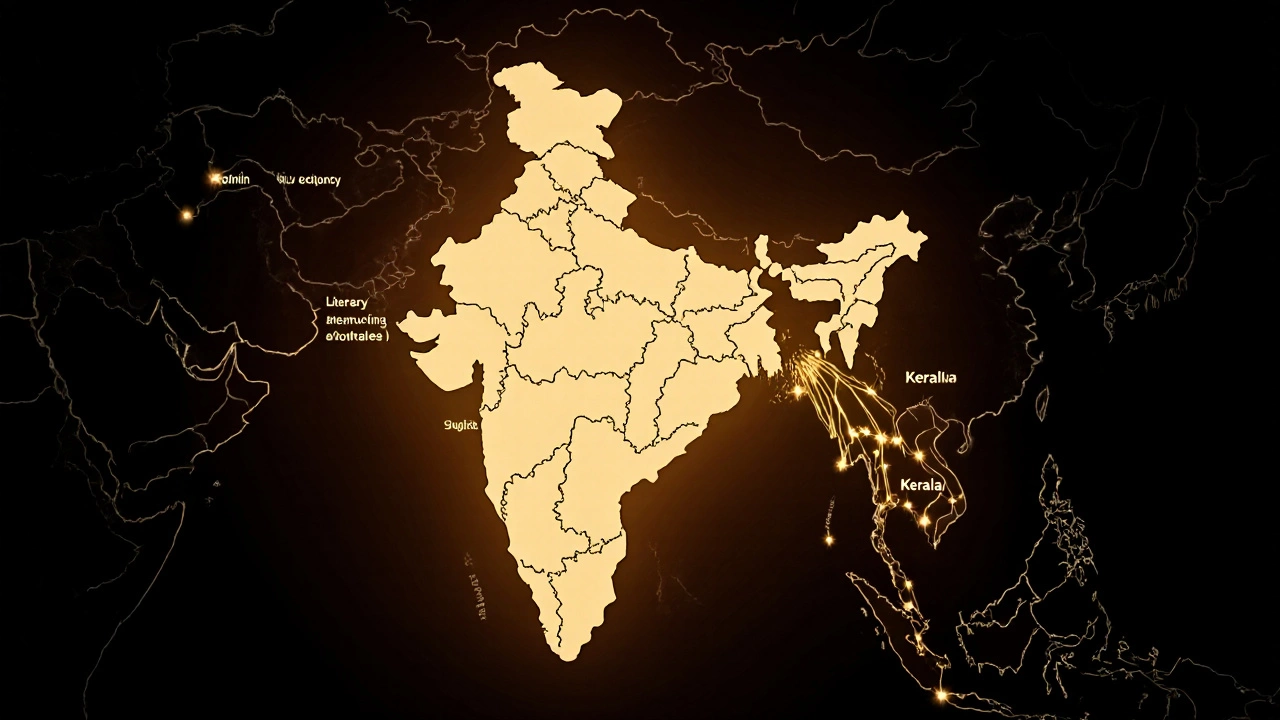SEARCH
Is Kerala Rich or Poor? The Real Economic Story Behind India’s Most Developed State


Kerala Remittance Impact Calculator
How Kerala's Remittances Create Wealth
Kerala receives ₹1.5 lakh crore annually from over 2.5 million workers in the Gulf. Unlike other states where remittances concentrate wealth, in Kerala they create widespread opportunity. See how this money transforms lives:
Your Remittance Impact
Unlike other states where remittances benefit only a few families, Kerala's distributed model means:
✓ Every ₹100 in remittances funds a new home in a village
✓ Every ₹500 funds healthcare for a family
✓ Every ₹1,000 creates a small business opportunity
When people think of Kerala, they picture backwaters, coconut trees, and quiet beaches. But beneath the postcard beauty lies a deeper truth: Kerala isn’t just beautiful-it’s economically unique in India. While states like Maharashtra and Uttar Pradesh dominate headlines for their size or industrial output, Kerala quietly holds the title of India’s most developed state by human development indicators. So, is Kerala rich or poor? The answer isn’t about bank balances-it’s about how people live.
High Life Expectancy, Low Income
Kerala has the highest life expectancy in India: 77 years for men, 80 for women. That’s higher than China and close to the U.S. Meanwhile, the national average is just 70. This isn’t magic. It’s the result of decades of investment in public health and education. Kerala has near-universal access to clean water, basic healthcare, and free primary education. Even in remote villages, you’ll find a primary health center. In many parts of Bihar or Jharkhand, you’d be lucky to find a functioning one.But here’s the twist: Kerala’s per capita income is only about 70% of the national average. In 2024, it stood at ₹2.45 lakh per year, compared to India’s ₹2.82 lakh. So why does it feel richer? Because money isn’t everything. A farmer in Wayanad might earn less than a factory worker in Gujarat, but his child goes to school for free, gets free lunch, and visits the government clinic without paying a rupee. That’s wealth you can’t measure in rupees.
Education: The Real Engine
Kerala’s literacy rate is 96.2%, the highest in India. In 1947, it was already at 47%-far above the national average of 12%. That wasn’t luck. It was policy. In the 1950s and 60s, the Communist government pushed for universal schooling even when other states ignored rural areas. They built schools in villages, trained local teachers, and made education mandatory. Today, every child in Kerala, whether in a coastal town or a hilltop village, can read and write.This isn’t just about numbers. It’s about power. When people can read, they can demand better services. When they can understand their rights, they vote for better leaders. Kerala’s political system is shaped by this. Even the poorest households know how to file an RTI request or challenge a corrupt official. That’s not something you can buy with money-it’s built over generations.
Remittances: The Hidden Economy
One in four Keralites works outside India. Over 2.5 million people from Kerala live and work in the Gulf countries-Saudi Arabia, UAE, Qatar, Kuwait. They send home nearly ₹1.5 lakh crore every year. That’s more than the entire state budget. These remittances don’t just fill bank accounts. They build houses, fund small businesses, and pay for medical emergencies.Unlike other states where remittances go to a few wealthy families, in Kerala, the money trickles down. A driver in Kochi might use his brother’s Gulf salary to open a small grocery store. A teacher in Kollam might use her cousin’s savings to send her daughter to college. This distributed wealth creates a stable middle class-even if no one is rich by global standards.

Healthcare: Free, But Not Perfect
Kerala’s public health system is the envy of India. The state runs over 1,200 primary health centers and 140 community health centers. Maternal mortality is 43 per 100,000 live births-nearly half the national average. Infant mortality is 7 per 1,000, compared to 28 nationally. This isn’t because Kerala has more doctors. It’s because it has more community health workers-ASHAs and ANMs-who visit homes, track pregnancies, and vaccinate children.But there’s a catch. Hospitals are underfunded. Specialists are scarce. Many people still travel to Bangalore or Chennai for cancer treatment. The system works well for basic care, but fails under heavy demand. The state spends only 5% of its budget on health-less than the World Health Organization’s recommended 7%. So while the system is better than anywhere else in India, it’s not perfect.
The Poverty Paradox
Kerala’s official poverty rate is 0.7%-the lowest in India. That sounds incredible. But poverty here doesn’t mean hunger. It means lack of opportunity. Many young people graduate with degrees but can’t find jobs. Unemployment among graduates is over 15%. The state has no big industries. No Tata Motors. No Infosys campuses. No steel plants. Most jobs are in government, education, or tourism.So while no one starves, many feel stuck. A 25-year-old with a B.Com degree might work as a clerk in a bank for ₹18,000 a month. He can afford rent, food, and a phone-but not a car or a house. That’s not extreme poverty. But it’s not upward mobility either. That’s why so many leave for the Gulf or move to Bengaluru.

What Kerala Gets Right
Kerala proves that development isn’t about GDP. It’s about dignity. The state spends more on schools than on highways. It gives free textbooks to every child. It runs public kitchens for the elderly. It has 100% electrification, 99% sanitation coverage, and universal access to clean drinking water.Compare that to Uttar Pradesh, where 40% of children are stunted from malnutrition, or Rajasthan, where 30% of villages still lack electricity. Kerala doesn’t have the biggest economy-but it has the most equitable one.
Why It Can’t Be Replicated
Other states try to copy Kerala’s model. But they fail. Why? Because Kerala’s success isn’t just policy-it’s culture. There’s a deep-rooted belief in collective welfare. People trust the government. They vote for education, not just handouts. There’s also a strong tradition of social movements-from land reforms in the 1970s to women’s self-help groups today.Other states have money. Kerala has social capital. You can’t buy that. You can’t import it. It’s built slowly, over decades, through trust, participation, and shared values.
Is Kerala Rich or Poor?
Kerala isn’t rich in money. But it’s rich in health, education, and equality. Its people live longer, learn more, and suffer less than anywhere else in India. It’s poor in jobs and industry. But rich in human potential.If you’re looking for a state that shows what’s possible when you invest in people-not just infrastructure-then Kerala is the answer. It’s not the richest. But it’s the most humane. And in a country where millions still die from preventable diseases, that matters more than any GDP number.
Why is Kerala’s poverty rate so low despite low income?
Kerala’s low poverty rate comes from universal access to healthcare, education, and food security. Even low-income families get free medicines, school meals, and subsidized housing. The state doesn’t rely on cash handouts-it provides services that prevent people from falling into poverty in the first place.
Does Kerala have unemployment problems?
Yes. Kerala has one of the highest graduate unemployment rates in India, at over 15%. The state lacks large-scale industries and private sector jobs. Many educated youth end up working in government roles or leave for cities like Bengaluru or abroad to the Gulf.
How does Kerala compare to other South Indian states?
Tamil Nadu and Karnataka have higher per capita incomes and more industries. But Kerala beats them in health and education outcomes. For example, Tamil Nadu’s infant mortality is 18 per 1,000; Kerala’s is 7. Karnataka’s literacy is 83%; Kerala’s is 96%. Kerala trades economic growth for human development.
Are there signs of economic decline in Kerala?
Yes. Remittances from the Gulf are falling as oil prices drop and Gulf countries reduce foreign labor. Youth migration is rising. The state’s public sector is overburdened. Without new industries or tech hubs, Kerala risks stagnation. But its strong social safety net prevents collapse.
Can other Indian states learn from Kerala?
Absolutely. Kerala shows that investing in health and education delivers long-term returns. States like Odisha and Madhya Pradesh have improved by copying Kerala’s ASHA worker model. But they can’t copy the culture of participation. Real change needs community trust-not just policies.